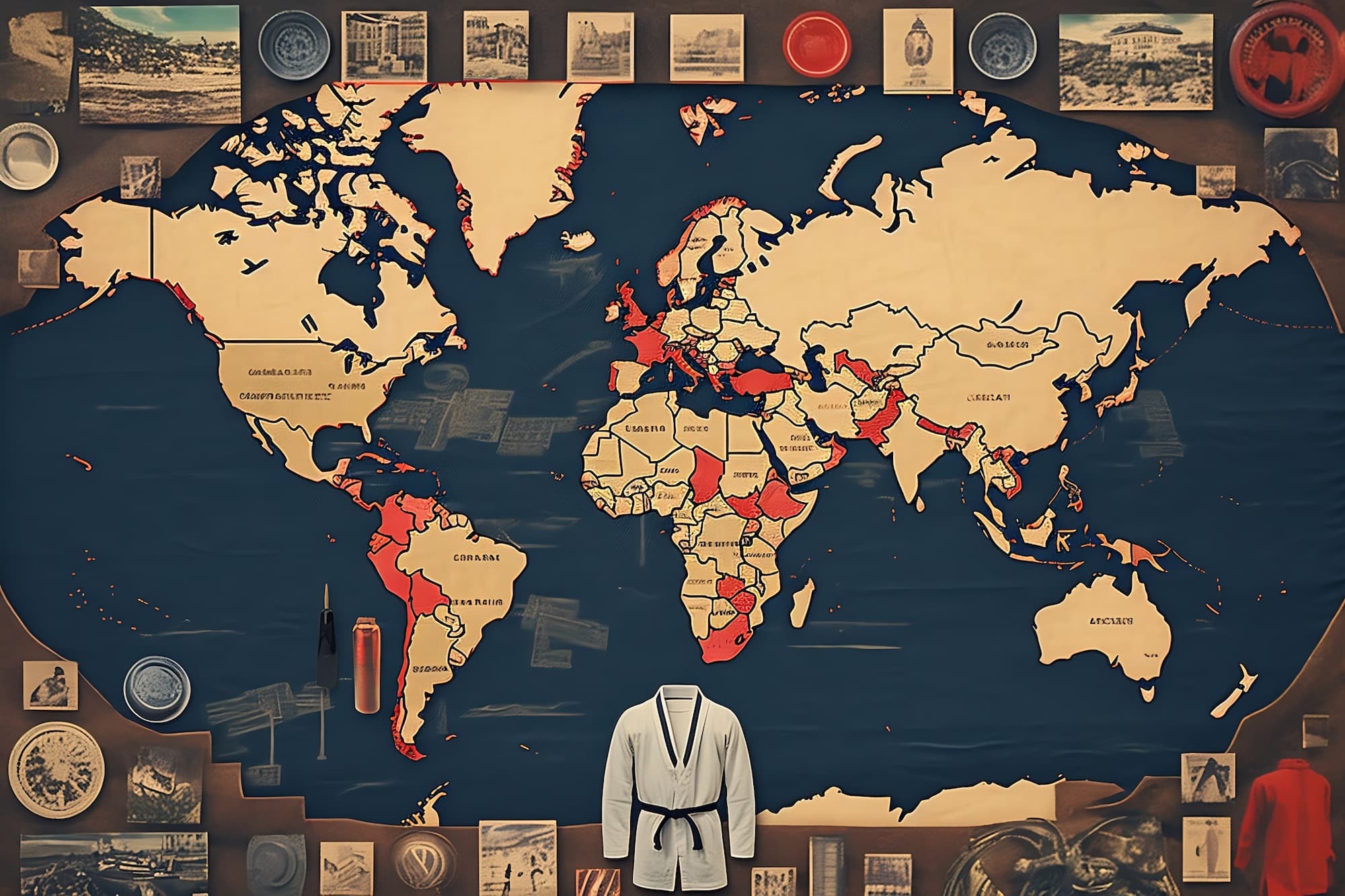Today marks two years in to this ludicrous sport into which I somehow got myself involved, and to which I decided to dedicate myself.
Through jiu jitsu — and more broadly, combat sports including all striking, grappling, and combined mixed martial arts — I've learned so much about myself, made so many awesome friends, and found so many moments of pure joy. It's ridiculous how late in life I found it. (Here's how I moved from CrossFit / powerlifting to BJJ.)
Below is a brief review of stats, reflections, and a path forward.
As I write this, I'm in Istanbul, Turkey, training with Özdemir Kızılkan at his excellent club Inferno Jiu Jitsu Club, and having the time of my life training there five-six days a week.

Two Years of Combat Sports — Stats
Here's an overview chart of my progress so far. I keep a very detailed log of types of classes, hours done, and what we learned, and this is the result! Isn't it pretty...

Here are the top-level stats.
- 697.5 hours of training in total. I trained for average 0.95 hours a day, but not every day... on 547 of the days (75% of the days available), for 1.28 hours per class on average.
- 496.75 hours of my training was jiu jitsu / grappling. Roughly half-half gi and no-gi, with a few judo classes in between (It really just depended on the school and teacher and my timetable, I had to be flexible, despite my preference for no-gi.)
- 200.75 hours of my training was striking, including Muay Thai, boxing, "MMA"-style striking, and general bag time doing drills.
People often ask me where I'm from, and I say Australia. They then ask me where I train, hoping I'll say Absolute MMA! (I haven't yet, but I will, in 2024.)
I started my training under Shaun King at SASSOM MMA in Brisbane. He has since moved on to his own gym.
But since then, I've trained (for significant periods) in
- Fusion Fight & Fitness in Cairns, Queensland, Australia. Including training with the Muay Thai coaches / team that have now split away to become Pretty Top Team.
- Académie Jaunbocus Tawfiq (AJT) in Mauritius
- Cercle Tissier in Paris, France
- Cube MMA in Seoul, Korea
- Vera Fight Club in Buenos Aires, Argentina
- Dog Eat Dog MMA in Florence, Italy

I've also done stints of a few weeks at 10th Planet in Orange County, California, USA, and Montenero Boxing in Milan, Italy.
I've trained in Jiu Jitsu in six languages so far. But I must admit, I only could actively participate all the time in French, Spanish, and Italian. I could occasionally ask questions in Korean. My Korean was middling — I understood basic explanations but not the complex monologues given by my coach. And my Turkish is very day-to-day functional so I rely on my coach's excellent English.
Reflections
I've learned a lot about myself, about what makes a good MMA gym, and how I enjoy training.
When I started this out, I thought "I'm going to learn Brazilian Jiu Jitsu". I didn't know the difference between gi and no gi. In fact, I didn't know what a gi was, until my coach asked me if I had one.
Since then, I broadened out what I like doing to gi and no-gi, then grappling generally, then grappling + muay thai, then really just grappling + striking and mixed martial arts.
I have no cage ambitions, but I do enjoy mixing up the sports. I sometimes do striking, sometimes do grappling, and get different kinds of joy from each.
The weird thing about saying I enjoy "MMA" is that I don't want to take part in competitive combat. Amateur, at most. But I don't want to inflict harm on someone else or get hit in the head myself. I like the art of it and the sport of it. What I enjoy most is training with my friends, and I don't want to hurt my friends!
On changing gyms — it sucks for a number of reasons. I don't like changing gyms because
- When going somewhere new, it's very hard to find a good gym that's easy to get to. Many parts of the world just have a few gyms. (Doing sport for fun and not competition is mainly a western concept)
- I just start to make friends / find good training partners, and then have to move on
- The coach only starts to "get" me after a few weeks, and I have to re-start that process every time
- I only spar lightly in the first weeks with people, and it gets heavier as we get to know each other.
The risk of injury when changing a gym is very high. I'm on red alert for the first week. After that, I get a lay of the land, and can figure it out more.
But on the plus side, changing gyms constantly has some benefits:
- I get exposure to a wide variety of styles. I train in different striking and grappling disciplines, see the preferences of different kinds of coaches who've had different backgrounds and are of different sizes, and so on.
- I meet a ton of people and make a lot of friends.
- I learn how to run my own curriculum and direct my own training.
I've had to get my own resources, like The Grapplers Guide and various instructional courses from BJJ Fanatics, and try to figure out stuff myself. For example, I might think "I'm terrible at guard passing" and so watch a few videos on the topic.
In terms of gi / no-gi, or grappling vs striking — I have learned to just do whatever a coach does well. Fran in Buenos Aires did a lot of no-gi and boxing, so that's what I did with him. Fred in France did gi, so that's what I did. Whatever I do, I improve, stay fit, and make friends, and those are the most important things to me.
The Path Forward
I'm going to continue what I'm doing — moving between gyms. I like to travel. I just have to keep improving the way I adapt.
I've got a few resolutions for how I'm going to keep working on my combat sports progress.
Firstly, I'm going to keep working on my own curriculum. Currently I have a list of things I need to improve — takedowns, guard passing, getting to the back, attacking the back, and wow, a lot of things already — and I've got to be more disciplined in adding to my vocabulary and doing practise and drills with partners.
Secondly, I'm going to go the best gyms. I've learned more about what makes a good gym. Generally, it starts with the top — an excellent coach builds good culture, and good culture makes for a good gym. A few gyms I'm looking forward to visiting in the future are 10th Planet in Orange County again (where my partner's family lives), Absolute MMA in Melbourne, and somewhere in Europe again — depends where I end up.
Thirdly, I'm going to improve my mental game — self belief. One thing I struggle with in combat sports is insecurity. I'm always battling with myself, asking questions like: "Why am I not better than I am for someone who has trained this long?", "Why is this relatively junior person able to dominate me?", or "Why am I plateauing?"
It could be summarised best as impostor syndrome — the feeling that I'm a "fake" blue belt, that I'm not a natural, and that I'm terrible. It's hard to not let it weigh me down. Anyway, this is a topic for another day. Suffice it to say that in my training, as in many other disciplines, I risk being my own worst enemy, but must work to remember that I'm also my own strongest ally.
Finally, I'm going to be flexible in my schedule and my training. I've realised that good training comes in bursts, but that I need breaks, and to spend time doing "vacation" things with my partner. They're good for me and they're good for us. So I'll be less obsessive about training all the time, and accept that breaks are inevitable and OK.
Most importantly, I have a long journey ahead. I'm not in a rush to get "belts" anymore, as I was at the beginning. I just want to get better over time, fight the Battle of the Bulge, and make friends. Those are the things that bring me joy, not incremental milestones. I'll remember that!

